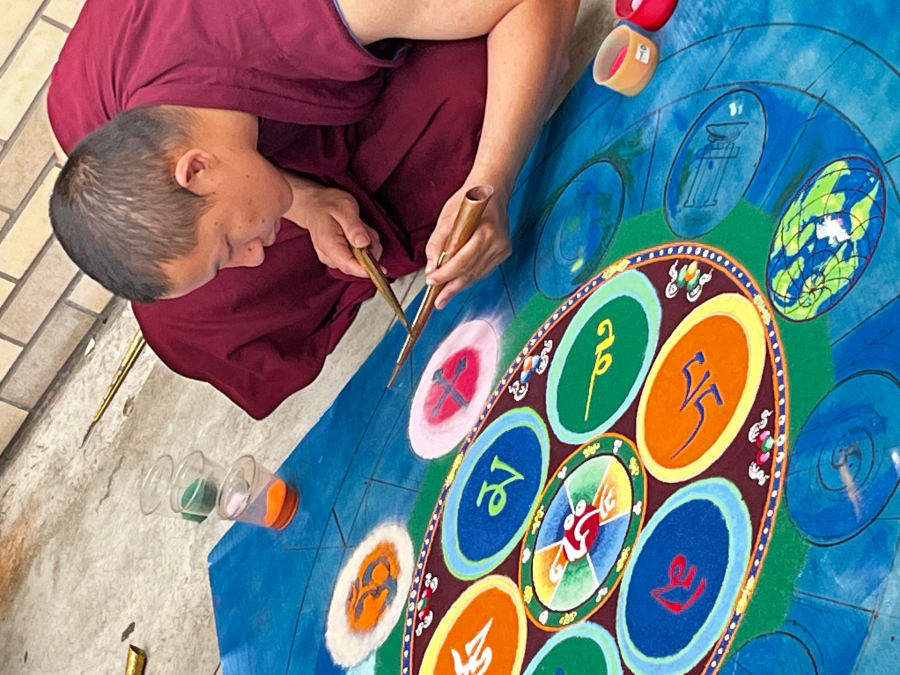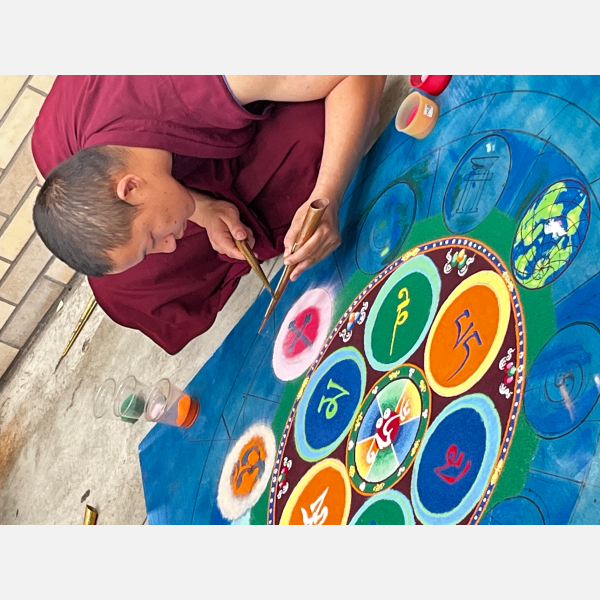Students Benefit from the Teachings of Tibetan Monks
Three monks dressed in red garb sat hunched over a beautifully intricate temporary artwork composed of water-colored sand, carefully filling in a pre-drawn sketch with a silent motivation palpable to those who passed.
The Tibetan monks brought the teachings of Buddhism to Bradley’s campus, April 28 to May 2. Tenpa Phuntsok, head chantmaster and translator, provided insight on their practice.
Phuntsok was born into Buddhism, which plays a major role in Tibetan culture. He didn’t truly dive into the inner workings until he was 19, when he started learning from the Tashi Kyil monastery.
“The rituals, prayers, morals and culture are what intrigued me,” said Phuntsok. He especially highlighted the continuous message of kindness. “The more I teach others, the more appreciation I develop for the practice.”
“I wanted to give people this connection with people who were born on the other side of the planet because not everybody can experience this, and it’s our job as educators to give that to them,” said Dr. Sara Conrad, anthropology professor and organizer of the monks’ week-long visit.
During the monks' time on campus, they emphasized the words of Chenrezig—a tenth-level bodhisattva associated with great compassion.
“Compassion with wisdom is like a bird with two wings,” said Phuntsok. “There are so many of us on this Earth. One without the other prevents flight, but the two together form union.” Phuntsok and the other visiting monks spent five days working on the ultimate symbol of compassion and union: a sand mandala.
Using a chakpur, a small funnel that uses vibrations to drop colored grains of sand, the trio of monks slowly built up the sand mandala that echoed the ethics of Chenrezig. The inner circles included imagery from worldwide religions, encased by Buddhist symbols like the lotus flower. The process is tedious, requiring hours of sitting and patience. And if they mess up? Phuntsok just “happily fixes it.”
Sand mandalas teach monks how to be present and in the moment, something students can learn from. It’s easy to lose connection with the good things when homework and tests have you worried. But stress is temporary. And so are sand mandalas.
At the end of the week, the three monks welcomed students to watch the destruction ceremony, a crucial part of the sand mandala process.
“It’s one of the main teachings of Buddha: even beautiful things are impermanent. Nothing lasts forever,” said Phuntsok. “But that acceptance of impermanence gives us the capability to calm the self and minimize the pain of attachments when we cannot let go.”
As finals approach, students can pick up valuable life lessons from Buddhism and from the temporary artwork of sand mandalas. While stress is taking over right now, with papers and tests to worry about, Phuntsok reminds us to be mindful.
“The most important lesson Buddha teaches us is the practice of contentment,” he said. “If you’re content, wherever you go and whatever happens, you will be happy.”
“They brought such positivity to campus, and I think everyone—no matter what their belief system is—benefitted from their visit,” Conrad said.
The teachings of Buddha and the importance of cultural connection expresses a clear message that all students can benefit from: the stress of finals is temporary. Kindness, self-confidence, and happiness is forever.
—Hermes Falcon, senior journalism and sociology major





